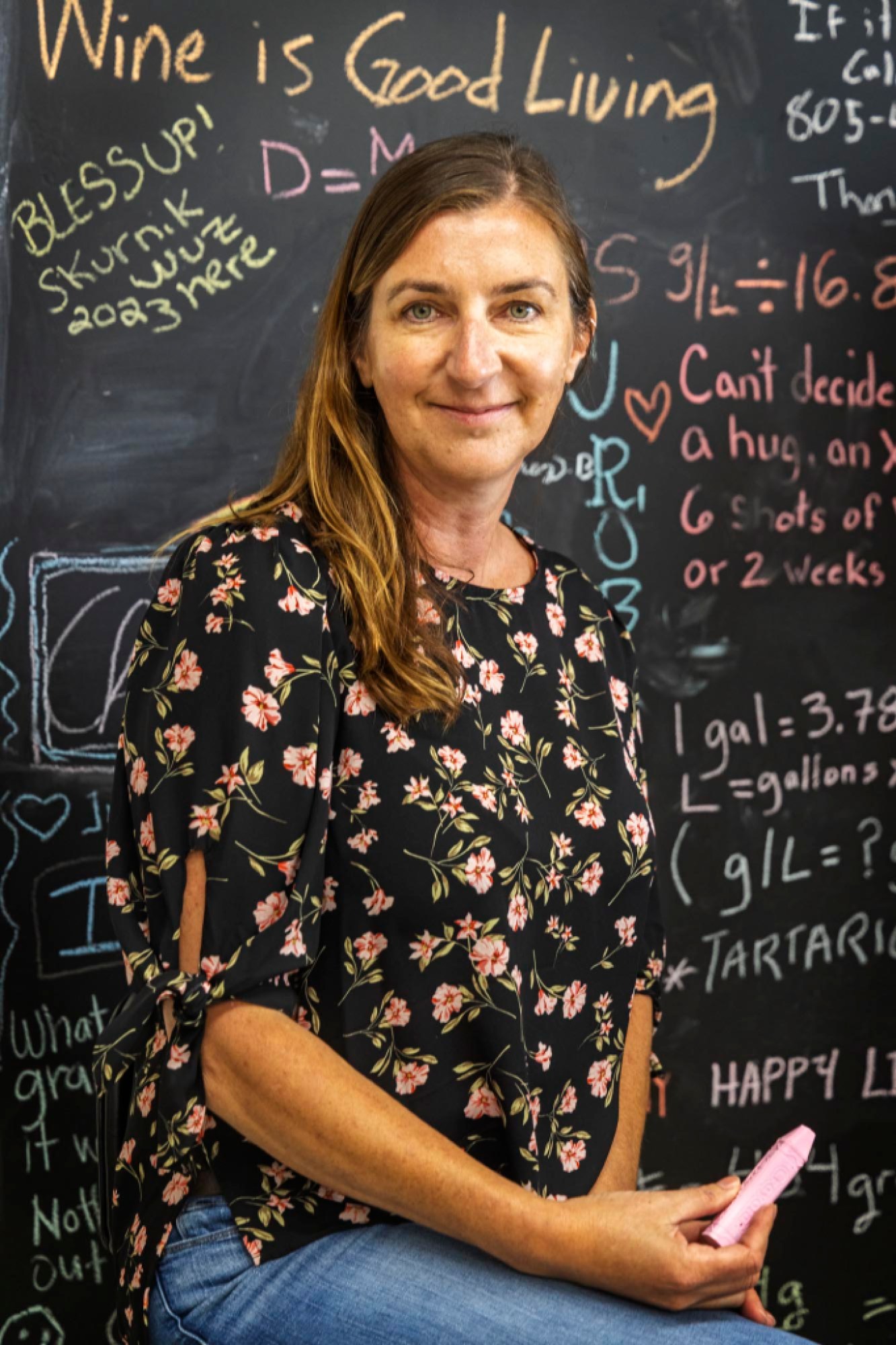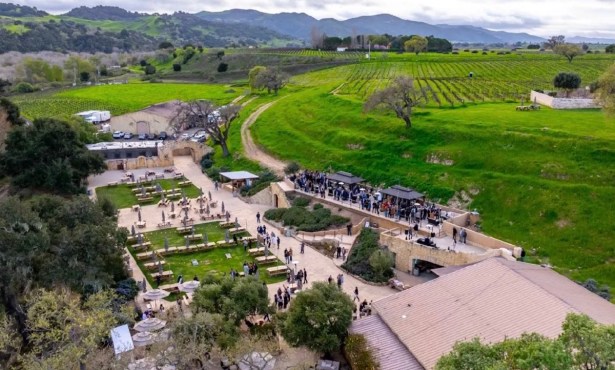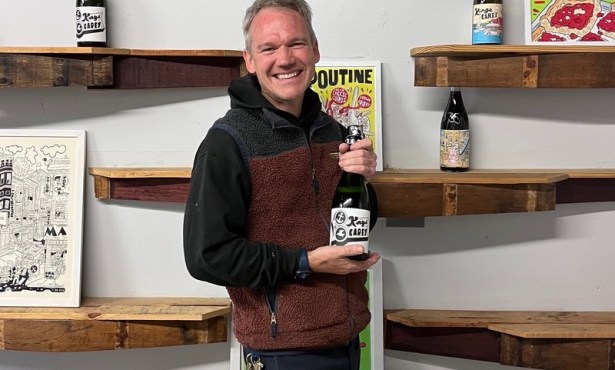Santa Barbara County
Grows All the Wine Grapes
Why Progressive Farmers and Winemakers
Are Doubling Down on Diversity
By Matt Kettmann | Photos by Macduff Everton | April 27, 2023

The early-morning spring fog was thick, but we could still see the parade of signs at the end of each vineyard row, listing the plantings of vermentino, picpoul blanc, counoise, and lagrein as we rambled through the Santa Ynez Vineyard on the easternmost flanks of Happy Canyon. These grape varieties were not the pinot noirs, chardonnays, cabernet sauvignons, or syrahs that dominate Santa Barbara County’s — or even California’s — viticultural landscape, and some, such as montepulciano and clairette blanche, have almost no track record in American wine at all.
Since the early 2000s, as pinot noir and chardonnay exploded, syrah gained a foothold, and growers finally figured out where to grow cab properly, Santa Barbara wine country has grappled with being too many things at once. It’s hard, it turns out, to broadly market somewhere where so many grape types truly thrive in such slim stretches of the Santa Ynez and Santa Maria valleys. Whereas Napa owns cab, Sonoma claims pinot and chard, and even Paso Robles can tout red blends, Santa Barbara’s one-of-a-kind geography — the only place on the entire west coast of the Americas where valleys lie perpendicular to the Pacific Ocean, thanks to the force of the San Andreas Fault — enables almost every wine grape variety on the planet to succeed.
Yet in the face of that marketing hardship, these new plantings at Santa Ynez Vineyard — and at a smattering of other properties, like Nolan Vineyard in Los Alamos, Le Bon Climat near Santa Maria, and Black Oak in Los Olivos — are doubling down on such diversity. With an eye on sustainability in both economic and environmental terms, forward-thinking farmers and winemakers are giving consumers what they want, which increasingly are lower-alcohol, higher-acid, sustainably grown, and, most importantly, more affordable wines. In so doing, Santa Barbara County is positioning itself as a place for not only one grape, but for all the grapes, attempting to do in 3,800 square miles what the entire country of France does across a landscape 50 times the size.
“Imagine if we’re taking on Bordeaux and the Rhône and Burgundy and all of those varieties and then some, and it’s all in one compact place called Santa Barbara County?” ponders Bryan Babcock, who began pioneering Sta. Rita Hills pinot noir and chardonnay in the 1980s but is more exhilarated than ever to be bottling petit verdot, picpoul, clairette, carignan, and mencía. “We’ve got to get past the idea that we have to say, ‘We are pinot,’ or ‘We are syrah.’ What we need to start saying is that we are a phenomenon. That’s what I see coming.”
Grapes Galore
I wouldn’t even know where to start a comparative study, but I’m pretty certain that, with more than 75 wine grape varieties already in the ground, Santa Barbara County must be growing a wider range of grapes than anywhere else in the world across less than 16,000 collective vineyard acres. While emerging regions often dabble in varieties for decades before getting a couple of them right, Santa Barbara’s conundrum is that they all seem to work. While the weather tends to be quite moist and chilly toward Lompoc and Santa Maria, it’s much drier and warmer as you inch inland toward the Los Padres National Forest, reenacting everywhere from Champagne to the Greek isles. There’s chalk, clay, loam, sand, and igneous soils scattered amid the tumultuous geology, and slopes spanning all four directions, sucking up abundant sunshine that’s refrigerated by fog, wind, and sporadic winter showers.

UNUSUAL SUSPECTS: Picpoul blanc, clairette blanche, and other obscure grapes are now growing at Santa Ynez Vineyard. | Credit: Macduff Everton
Explaining as much in two minutes to a wine buyer in Houston or food-fest attendee in Tallahassee can be a challenge, but I’ve always found this diversity to be the selling point. You can bring a big group of friends to Santa Barbara wine country and everyone can find a wine they’ll love, from racy, enamel-ripping grüner veltliner grown in Lompoc’s diatomaceous earth to lush, age-worthy cab grown on the serpentine soils below Figueroa Mountain. And I’m not the only one.
“I just see opportunity in Santa Barbara,” said vintner Andrew Jones, who’s based up north in Paso Robles. “It’s definitely leading the way in diversity.”
He would know. Since his last year at Cal Poly in 2002, Jones, who was raised in Camarillo, has worked for Sunridge Nurseries, the largest wholesale grapevine nursery in the United States. Today, he’s vice president of wine grapevine sales — meaning that he touches every vine deal that Sunridge does across the country — and is also the owner and winemaker of Field Recordings, the brand he launched in 2007.
“It was a way to keep me busy during the fall,” explained Jones of why he started the brand to occupy the nursery’s slow season. “And I was also dealing with the winemakers for picking out grapes to plant way more than the vineyard managers. I wanted to know more about that side of the business.”
Arguably more than any brand on the Central Coast, Field Recordings is known for bucking tradition, pushing the stylistic envelope, and crafting wines from obscure grapes and forgotten places. And Jones does most of it — including more traditional varieties, too — for about $25 a bottle, which is a screaming deal for handcrafted wine.
Though based in Paso’s Tin City, he buys grapes from all over the Central Coast for his wines, and started sourcing from Santa Barbara County in 2009, primarily from properties managed by Coastal Vineyard Care Associates. CVCA — or just “Coastal,” as most folks call it — is the rather ubiquitous vineyard management company started by Jeff Newton in 1983, now mostly run by Ruben “The Grape Whisperer” Solorzano, Ben Merz, and Mike Testa.

“The one reason Santa Barbara is such a leader is because Coastal Vineyard Care is super progressive compared to a lot of the other farm management companies,” said Jones, who recently partnered with Testa on vineyard projects and a brand called So Far Out. “They’re one of the most wine-savvy wine management groups in the state. That’s a big point of pride that Jeff established years ago. It’s trickled down to Ben and Mike and the whole team there.”
Last year, Jones, Testa, and Anthony Bozzano — plus investors via a digital platform called AcreTrader — purchased Le Bon Climat Vineyard in the Santa Maria Valley from the family of the late, legendary vintner Jim Clendenen. Needing to replant the entire aging property, they put in a few nods to the classic Burgundian grapes like pinot noir and chardonnay that Clendenen elevated through his Au Bon Climat brand, and then went wild with 16 different varieties across the 53 acres, including grolleau, mencía, melon, pineau d’aunis, poulsard, savagnin, and trousseau.
“We’ve got stuff there that I can’t even pronounce,” laughed Testa, a fifth-generation farmer from Santa Maria who went straight from Cal Poly to almost a decade of climbing up the ladder at E&J Gallo before CVCA brought him home in 2014. “We’re just trying to reach what the consumers want. When I worked for Gallo, they did the same thing. They didn’t create what they thought would work. They created what the consumer told them they wanted.”
Good for the Gander
The benefits of embracing these oddball varieties are multifold. On the economic front, they can achieve optimal ripeness earlier in the season — which appeases winemakers buying fruit — while boasting a significant crop weight, which appeases farmers selling fruit. On the environmental front, the shorter season means less water used and healthier, better-rested vines that won’t need to be replanted so soon. Many of these varieties hold their acid levels during the recurrent heat spikes brought on by climate change, making for the bright, fresh, zippy wines that are all the rage right now, and for the foreseeable future.
Testa was hired in large part to help CVCA evolve from primarily farming for Santa Barbara County estates that made their own wine into an operation that’s more focused on selling grapes to the ever-growing segment of wineries from across California that don’t own their own land.
“The growth we’ve experienced over the last 10 years has not been around more Jonatas or Crown Points,” said Testa, referring to prominent estates that they still work with. “Now we sell to over 400 different winemakers. We’re listening to what they want as opposed to telling them what we have.”
When someone asks for a grape they don’t grow? “Instead of saying, ‘No,’ we say, ‘We don’t today, but we can do it for you.’ We’ve been more accommodating than ever, and it’s paid off.”

The first project that really opened his eyes was Portico Hills adjacent to Los Alamos, where they planted cabernet franc, way more grenache than seemed wise, and, by accident, graciano, among more traditional choices.
“All of the sudden, that became a hit vineyard. We immediately saw the reward,” said Testa. “That really got us more comfortable branching out into things that are not the black-and-white, cookie-cutter grapes, and really trying to be more creative.”
At various vineyards around the county, from Foxtrot in Cebada Canyon to Rancho Los Alamos, he started planting marselan, mondeuse, tibouren, and petit manseng, eventually convincing even large-investment-portfolio vineyard owners to get creative with pinot meunier and aligoté. Some of these new plantings aren’t really new grapes for California at all, such as lagrein, barbera, and carignan, which were popular in the pre-Prohibition era.
“These are a lot of varieties that I used for jug wine in Fresno,” said Testa of his Gallo days. “They’re really not emerging. They were out of vogue for a long time, and they’re coming back because they’re so conducive to sustainable farming. They have big clusters; they’re thick-skinned; they retain acid. They can take the heat.”
Arinto, Anyone?
“For a grape farmer, this is heaven,” explains CVCA’s Ben Merz as we weave through the Santa Ynez Vineyard, beneath the $60 million mansion being built for billionaire owner Jay Paul. The groundwater is clean and plentiful, the soils are ideal, and the property — which sits on a 1,000-acre conservation easement behind Lake Cachuma — is isolated, erasing worries about grapevine diseases coming from neighbors.

Merz started work on the vineyard about seven years ago, and its current 170 acres include significant chunks of cabernet sauvignon, syrah, and sauvignon blanc, as well as that laundry list of 26 other varieties. “There is amazing word-of-mouth for this vineyard,” said Merz of how well the rare varieties are selling. “It can satisfy the low-alcohol folks; it can satisfy the high-alcohol folks.”
A significant client is Alisa Jacobson, the winemaker who grew Joel Gott Wines from a tiny family operation into a juggernaut producing more than one million cases a year. After nearly two decades of scouring the entire West Coast for grapes to feed that beast, Jacobson decided to plant the roots for her own brand in Santa Barbara County, choosing this region over everywhere else for our environmental bent, entrepreneurial spirit, relative affordability, and the fact that grapes have not become a monoculture like she saw happen to Napa. She now makes picpoul blanc, a grüner veltliner–chenin blanc blend, a Rhône red, and more under the label Turning Tide Wines.
“It makes the vineyard more exciting,” said Jacobson on our tour that foggy morning, explaining how intriguing grapes can draw winemakers into new vineyards. She’s a major proponent of organic farming and partnered with Merz and others on a couple other properties, including a certified organic sauvignon blanc vineyard called Rancho Pequeño on Baseline Road and another one called Mora full of Italian and Iberian grapes like loureiro and verdelho. (That one’s for sale, if anyone wants in.)
Jacobson took over the production space at the old Bridlewood Winery because the new owner, a developer named Scott Ehrlich, is deeply focused on sustainability. “He aligned with my ethos,” she said. Though most of CVCA’s vineyards are farmed organically — albeit, not always certified — and a half-dozen or so are managed biodynamically, this vineyard is the first foray that Merz is taking into regenerative farming, which puts him regularly on calls with a dozen different consultants. They’re also looking at planting one or two emerging grape varieties, likely vermentino.

PIONEERING STILL: Bryan Babcock conquered pinot noir and chardonnay but is now fired up about petit verdot and carignan. | Credit: Macduff Everton
As we toured the winery, Bryan Babcock showed up with bottles in tow. He was fired up to show us an arinto that Lo-Fi made from Riverbench in the Santa Maria Valley, listán blanco and gual from the Canary Islands, and his first bottling of mencía from Nolan Vineyard, as well as his picpoul, carignan, and petit verdot, all from Santa Ynez Vineyard.
“He’s gone out of his way to really fly the flags of these varietals,” Testa told me later over the phone. “I listen to him because he’s earned it. He was right about mencía and about clairette and about picpoul.”
Testa wants to push further. “If you’re just doing what has worked in the past, you’re going to lose to these massive institutions that have plenty of money and patience,” he said. “We need to be putting our neck out there and hope we’re pointing toward where the trend is going and not just following.”
As we sipped through the flight, Merz shared Babcock’s affinity for mencía, which tastes like a cross between juicy pinot noir and spicy syrah. “It probably wouldn’t be a bad idea to plant more of this one,” said Merz.
Despite a career turning the Sta. Rita Hills into a global pinot noir hotpot, Babcock is welcoming the newness more than anyone, and he doesn’t care about the haters. “Anytime you push away from the status quo, there’s confusion,” he said. “Well, okay, but thank god we had the renaissance in Europe. Otherwise, who knows where we would be.”
Altogether, the farmers and winemakers see this trend as continuing the Santa Barbara tradition of embracing young winemakers, incubating new brands, and preferring the experimental over the established.
“I still sense the maverick spirit here, whereas, if you go to Napa, you go to make cab and you better have a trillion dollars,” said Babcock. “Or you can come to Santa Barbara County, rent out a garage, and do whatever you want.”





You must be logged in to post a comment.